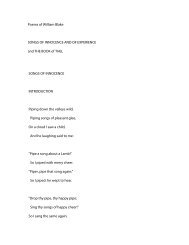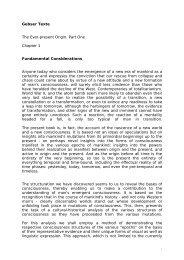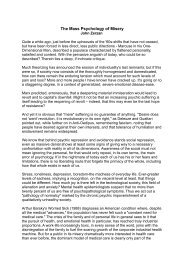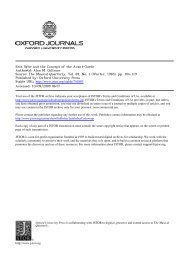How Kubrick Faked the Moon Landings - Michael Goodnight - Editor
How Kubrick Faked the Moon Landings - Michael Goodnight - Editor
How Kubrick Faked the Moon Landings - Michael Goodnight - Editor
You also want an ePaper? Increase the reach of your titles
YUMPU automatically turns print PDFs into web optimized ePapers that Google loves.
<strong>How</strong> Stanley <strong>Kubrick</strong><br />
<strong>Faked</strong> <strong>the</strong> Apollo <strong>Moon</strong> <strong>Landings</strong>:<br />
Or <strong>How</strong> I learned to Stop Worrying and Love <strong>the</strong> Lies.<br />
Alchemical <strong>Kubrick</strong> II<br />
By Jay Weidner<br />
Copyright July 20 th 2009<br />
Sacred Mysteries Productions<br />
"There are great ideas, undiscovered breakthroughs available, to those who can remove<br />
one of truths protective layers"<br />
-Neil Armstrong, 'First Man on <strong>the</strong> <strong>Moon</strong>'. July 20 th 1994<br />
It has now been forty years since <strong>the</strong> fabled moon landings by NASA and <strong>the</strong> Apollo gang. When it comes to<br />
<strong>the</strong> subject of <strong>the</strong> moon landings, people tend to fall into two belief groups. The first group, by far <strong>the</strong> bigger<br />
of <strong>the</strong> two groups, accepts <strong>the</strong> fact that NASA successfully landed on <strong>the</strong> moon six times and that 12 human<br />
beings have actually walked on <strong>the</strong> surface of <strong>the</strong> moon. The second group, though far smaller, is more vocal<br />
about <strong>the</strong>ir beliefs. This group says that we never went to <strong>the</strong> moon and that <strong>the</strong> entire thing was faked.<br />
This essay presents a third position on this issue. This third point of view falls somewhere between <strong>the</strong>se two<br />
assertions. This third position postulates that humans did go to <strong>the</strong> moon but what we saw on TV and in<br />
photographs was completely faked.<br />
Fur<strong>the</strong>rmore this third position reveals that <strong>the</strong> great filmmaker Stanley <strong>Kubrick</strong> is <strong>the</strong> genius who directed<br />
<strong>the</strong> hoaxed landings.<br />
1) MOTIVATIONS FOR FAKING<br />
But why fake <strong>the</strong> moon landings at all? What would be <strong>the</strong> motivation? Authors Joseph Farrell and Henry<br />
Stevens both have shown us undeniable proof that Nazi scientists had developed advanced flying saucer<br />
technology as early as 1943. These authors also show that <strong>the</strong> US Government brought <strong>the</strong>se same Nazi<br />
scientists into this country in order to build <strong>the</strong>se highly advanced flying machines.<br />
Fur<strong>the</strong>rmore, <strong>the</strong>y believe that <strong>the</strong> idea that aliens from outer space are invading <strong>the</strong> Earth is a clever cover<br />
story concocted by NASA to hide this technology.<br />
Many sources inside <strong>the</strong> military industrial complex have related to me that after John Kennedy was shown<br />
<strong>the</strong> flying saucer technology early in his Presidency, he realized that <strong>the</strong> advances in technology promised by<br />
<strong>the</strong> flying saucers could solve many of <strong>the</strong> pressing problems of <strong>the</strong> world. He saw that releasing this exotic<br />
technology would point <strong>the</strong> way towards cheap and environmentally friendly energy among o<strong>the</strong>r things.<br />
Soon after seeing <strong>the</strong> flying saucer technology, JFK made his famous speech asking NASA to land a man on<br />
<strong>the</strong> moon before <strong>the</strong> decade was out. Many insiders believed that this was a ploy by JFK to get NASA, and<br />
<strong>the</strong> secret government, to release <strong>the</strong>ir saucer technologies. Since it was obvious to everyone that standard<br />
rocket technology could not get man to <strong>the</strong> moon and back, JFK may have thought that NASA would be<br />
forced to release <strong>the</strong> knowledge of <strong>the</strong> technology behind <strong>the</strong> flying saucers in order to fulfill his vision and<br />
get to <strong>the</strong> moon by <strong>the</strong> end of <strong>the</strong> 1960's. JFK's ploy was <strong>the</strong>refore intended to free this advanced technology<br />
from <strong>the</strong> insidious hands of <strong>the</strong> shadow government.<br />
After <strong>the</strong> assassination of Kennedy in 1963, NASA began a new plan that would solve <strong>the</strong> problem that JFK<br />
initiated. This new plan would allow NASA, and <strong>the</strong> shadow government, to keep <strong>the</strong> saucer technology<br />
secret and to still make it look like standard rocketry had taken man to <strong>the</strong> moon and back.<br />
Someone high up in <strong>the</strong> shadow government decided to fake <strong>the</strong> entire moon landings in order to conceal<br />
<strong>the</strong> United States' extremely new and advanced Nazi technology both from us, <strong>the</strong> citizens and our enemies.<br />
In some ways NASA's position on this was understandable. We were in <strong>the</strong> middle of <strong>the</strong> cold war with <strong>the</strong><br />
Soviet Union. Did we really want to show <strong>the</strong> Russians what we had?<br />
2). WHO WILL FAKE IT?
In early 1964 Stanley <strong>Kubrick</strong> had just finished his black satire Dr Strangelove and was looking to do a<br />
science fiction film.<br />
While directing Dr. Strangelove <strong>Kubrick</strong> had asked <strong>the</strong> US Air Force for permission to film one of <strong>the</strong>ir B-52<br />
bombers for <strong>the</strong> movie. The Pentagon turned him down.<br />
The movie, Dr. Strangelove, was about a flight squadron that had been ordered to fly to Russia and drop<br />
nuclear bombs on that country. The Pentagon read <strong>Kubrick</strong>'s script and rejected his request to actually film<br />
<strong>the</strong> inside, and outside, of a B-52.<br />
The reason for this rejection was that <strong>Kubrick</strong>'s film was clearly a satire on <strong>the</strong> military and US nuclear policy.<br />
The Pentagon did not want to assist <strong>Kubrick</strong> in this satirical undertaking.<br />
Undaunted by <strong>the</strong> rejection, <strong>Kubrick</strong> used various special effects to create <strong>the</strong> B-52 in flight. When viewing<br />
Dr. Strangelove today, <strong>the</strong>se special effects look quaint and old fashioned, but in 1963 <strong>the</strong>y looked very<br />
good. It is possible that someone in NASA saw what <strong>Kubrick</strong> had done in Dr. Strangelove and, admiring his<br />
artfulness, designated <strong>Kubrick</strong> as <strong>the</strong> person best qualified to direct <strong>the</strong> Apollo <strong>Moon</strong> landing. If he could do<br />
that well on a limited budget - what could he do on an unlimited budget?<br />
No one knows how <strong>the</strong> powers-that-be convinced <strong>Kubrick</strong> to direct <strong>the</strong> Apollo landings. Maybe <strong>the</strong>y had<br />
compromised <strong>Kubrick</strong> in some way. The fact that his bro<strong>the</strong>r, Raul <strong>Kubrick</strong>, was <strong>the</strong> head of <strong>the</strong> American<br />
Communist Party may have been one of <strong>the</strong> avenues pursued by <strong>the</strong> government to get Stanley to<br />
cooperate.<br />
<strong>Kubrick</strong> also had a reputation for being a notoriously nasty negotiator. It would have been very interesting to<br />
have been a fly on <strong>the</strong> wall during <strong>the</strong> negotiations between <strong>Kubrick</strong> and NASA.<br />
In <strong>the</strong> end, it looks like Stanley <strong>Kubrick</strong> faked <strong>the</strong> moon landings in return for two things. The first was a<br />
virtually unlimited budget to make his ultimate science fiction film: 2001: A Space Odyssey, and <strong>the</strong> second<br />
was that he would be able to make any film he wanted, with no oversight from anyone, for <strong>the</strong> rest of his life.<br />
Except for his last film, Eyes Wide Shut, <strong>Kubrick</strong> got what he wanted.<br />
3). PARALELLING EVENTS<br />
It is uncanny <strong>the</strong> way that <strong>the</strong> production of 2001: A Space Odyssey parallels <strong>the</strong> Apollo program. The film<br />
production started in 1964 and went on to <strong>the</strong> release of 2001: A Space Odyssey in1968. Meanwhile <strong>the</strong><br />
Apollo program also began in 1964 and culminated with <strong>the</strong> first moon landings on July 20th 1969.<br />
Also it is very interesting to note that scientist Frederick Ordway was working both for NASA and <strong>the</strong> Apollo<br />
program and was also <strong>Kubrick</strong>'s top science advisor for 2001: A Space Odyssey.<br />
Once he negotiated <strong>the</strong> deal, Stanley, got to work. The most pressing problem for <strong>Kubrick</strong> in 1964 was to<br />
figure out a way to make <strong>the</strong> shots on <strong>the</strong> ground, on <strong>the</strong> surface of <strong>the</strong> moon, look realistic. He had to make<br />
<strong>the</strong> scenes look wide-open and expansive, like it was really done on <strong>the</strong> moon and not in a studio back lot.<br />
4). HOLLYWOOD TRICKERY.<br />
No one knows how many things he tried but eventually <strong>Kubrick</strong> settled on doing <strong>the</strong> entire thing with a<br />
cinematic technique called Front Screen Projection.<br />
It is in <strong>the</strong> use of this cinematic technique that <strong>the</strong> fingerprints of <strong>Kubrick</strong> can be seen all over <strong>the</strong> NASA<br />
Apollo photographic and video material.<br />
What is Front Screen Projection?<br />
<strong>Kubrick</strong> did not invent <strong>the</strong> process but <strong>the</strong>re is no doubt that he perfected it. Front Screen Projection is a<br />
cinematic device that allows scenes to be projected behind <strong>the</strong> actors so that it appears, in <strong>the</strong> camera, as if<br />
<strong>the</strong> actors are moving around on <strong>the</strong> set provided by <strong>the</strong> Front Screen Projection.<br />
The process came into fruition when <strong>the</strong> 3M company invented a material called Scotchlite. This was a<br />
screen material that was made up of hundreds of thousands of tiny glass beads each about .4mm wide.<br />
These beads were highly reflective. In <strong>the</strong> Front Screen Projection process <strong>the</strong> Scotchlite screen would be<br />
placed at <strong>the</strong> back of <strong>the</strong> soundstage. The plane of <strong>the</strong> camera lens and <strong>the</strong> Scotchlite screen had to be<br />
exactly 90 degrees apart. A projector would project <strong>the</strong> scene onto <strong>the</strong> Scotchlite screen through a mirror and<br />
<strong>the</strong> light would go through a beam splitter, which would pass <strong>the</strong> light into <strong>the</strong> camera. An actor would stand<br />
in front of <strong>the</strong> Scotchlite screen and he would appear to be 'inside' <strong>the</strong> projection.
Today Hollywood magicians use green screens and computers for special effects and so Front Screen<br />
Projection has gone <strong>the</strong> way of <strong>the</strong> Adding Machine and <strong>the</strong> Model T, but for its time, especially in <strong>the</strong> 1960's,<br />
nothing worked better than Front Screen Projection for <strong>the</strong> realistic look that would be needed both for <strong>the</strong><br />
ape-men scenes in 2001: A Space Odyssey and <strong>the</strong> faked Apollo landings.<br />
To see how Front Screen Projection looks on <strong>the</strong> screen let's examine <strong>the</strong> ape-men scenes at <strong>the</strong> beginning<br />
of <strong>Kubrick</strong>'s film 2001: A Space Odyssey. While viewing <strong>the</strong> stills from <strong>the</strong>se scenes, or watching <strong>the</strong>m in <strong>the</strong><br />
film, one has to remember that <strong>the</strong> early scenes in 2001 with <strong>the</strong> actors in Ape costumes were all done on a<br />
soundstage. None of what you are seeing in <strong>the</strong> ape-men scenes at <strong>the</strong> beginning of 2001 was actually shot<br />
outside. The scenes that surround <strong>the</strong> ape-men in 2001 are actually slides of a desert being projected onto<br />
Scotchlite screens standing at <strong>the</strong> rear of <strong>the</strong> set.<br />
In order to create <strong>the</strong>se desert backgrounds <strong>Kubrick</strong> sent a photographic team to Spain to shoot 8' X 10'<br />
Ektachrome slides. These slides were <strong>the</strong>n projected via <strong>the</strong> Front Screen Projection system onto <strong>the</strong><br />
Scotchlite screen. The actors in ape costumes stood in front of <strong>the</strong> screen acting out <strong>the</strong> script.<br />
If you watch 2001 on DVD you can actually see <strong>the</strong> 'seams' of <strong>the</strong> screen occasionally behind <strong>the</strong> gyrating<br />
apes. <strong>Kubrick</strong> was doing Front Screen Projection on such a huge and grand fashion that <strong>the</strong> technicians<br />
were forced to sew toge<strong>the</strong>r many screens of Scotchlite so that <strong>Kubrick</strong> could create <strong>the</strong> vastness needed for<br />
<strong>the</strong> ape scenes to be believable.<br />
In this still taken from an early scene in 2001 you can see <strong>the</strong> seams in <strong>the</strong> blue sky if you look closely.
Next is <strong>the</strong> same image as above only I have processed it through a graphic program. In this processing I<br />
have increased <strong>the</strong> gamma and increased <strong>the</strong> contrast.<br />
Please examine:<br />
Now we can clearly see <strong>the</strong> 'seams' and <strong>the</strong> 'stitching' of <strong>the</strong> Scotchlite Front Projection screen in <strong>the</strong> sky.<br />
To get <strong>the</strong> perspective correct one has to realize that <strong>the</strong> Scotchlite screen is right behind <strong>the</strong> rocky<br />
outcropping set, which was built on <strong>the</strong> soundstage.<br />
The lines on <strong>the</strong> screen are <strong>the</strong> flaws in <strong>the</strong> Scotchlite screen. These flaws in <strong>the</strong> screen give <strong>the</strong> sky give a<br />
peculiar 'geometry' when <strong>the</strong> image is properly processed to reveal <strong>the</strong> Front Projection Scotchlite Screen.<br />
Let's show ano<strong>the</strong>r example. Here is a still from <strong>the</strong> famous 'water hole' scene from 2001:
This next image is again <strong>the</strong> same image as above but with <strong>the</strong> gamma and contrast increased:<br />
While watching 2001,with <strong>the</strong> scenes of <strong>the</strong> ape-men, one can begin to see <strong>the</strong> tell tale fingerprints that<br />
always reveal when <strong>the</strong> Front Screen Projection system is being used.<br />
It should be emphasized that <strong>the</strong> sets that surround <strong>the</strong> ape-men in <strong>the</strong> movie are real. Those are 'real' rocks<br />
(whe<strong>the</strong>r paper mache or real) that surround <strong>the</strong> ape-men. But behind <strong>the</strong> fabricated rocks on <strong>the</strong> set, <strong>the</strong><br />
desert scene is being projected via <strong>the</strong> Front Screen Projector.<br />
One of <strong>the</strong> ways that you can tell <strong>the</strong> Front Screen system is being used is that <strong>the</strong> bottom horizon line<br />
between <strong>the</strong> actual set and <strong>the</strong> background Scotchlite screen has to be blocked. <strong>Kubrick</strong> strategically located<br />
rocks and o<strong>the</strong>r things near <strong>the</strong> bottom of <strong>the</strong> scene in order to hide <strong>the</strong> projection screen. In o<strong>the</strong>r words, <strong>the</strong><br />
camera and <strong>the</strong> viewers would see <strong>the</strong> bottom of <strong>the</strong> background projection screen if it weren't blocked in<br />
some fashion. As part of <strong>the</strong> 'trick' it became necessary to place things in between <strong>the</strong> screen and <strong>the</strong> set to<br />
hide <strong>the</strong> bottom of <strong>the</strong> screen.
I have photo-shopped a line differentiating <strong>the</strong> set and <strong>the</strong> background Scotchlite Front Projection Screen.<br />
Please note how everything is in focus, from <strong>the</strong> pebbles on <strong>the</strong> ground in <strong>the</strong> set to <strong>the</strong> desert mountains<br />
beyond.<br />
You will see that hiding <strong>the</strong> bottom of <strong>the</strong> Scotchlite screen is always being done when <strong>the</strong> Front Screen<br />
Projection system is used in 2001: A Space Odyssey. Hiding <strong>the</strong> screen is one of <strong>the</strong> fingerprints; it is<br />
evidence of its use. Just like <strong>the</strong> stage magician who needs <strong>the</strong> long sleeves of his costume to hide <strong>the</strong><br />
mechanism of his tricks, so too <strong>Kubrick</strong> needed to hide <strong>the</strong> mechanism of his trick behind <strong>the</strong> carefully placed<br />
horizon line between set and screen.<br />
Here is ano<strong>the</strong>r example from 2001: A Space Odyssey:<br />
And here is <strong>the</strong> same image with my photo shop line separating <strong>the</strong> set with <strong>the</strong> ape-man actor and <strong>the</strong><br />
Scotchlite Front Projection Screen.
And you will see, before this article is finished, that this same fingerprint, this same evidence, is clearly seen<br />
in all of <strong>the</strong> NASA Apollo stills and video footage.<br />
It is this fingerprint that reveals, not only that NASA faked <strong>the</strong> Apollo missions but also HOW <strong>the</strong>y faked<br />
<strong>the</strong>m.<br />
Let's examine a few NASA Apollo images now.<br />
This is a still from Apollo 17. This is also a great example of <strong>the</strong> Front Screen Projection process.
Again I have photo-shopped a line indicating <strong>the</strong> back of <strong>the</strong> set. One can see that <strong>the</strong>re is a slight uprising<br />
behind <strong>the</strong> rover, which is hiding <strong>the</strong> bottom of <strong>the</strong> screen. Also notice that even though everything is in focus<br />
from <strong>the</strong> lunar rover to <strong>the</strong> mountains in <strong>the</strong> background, <strong>the</strong>re is a strange change in <strong>the</strong> landscape of <strong>the</strong><br />
ground right behind my lines. This is because <strong>the</strong> photo of <strong>the</strong> mountains being used on <strong>the</strong> Front Projection<br />
system has a slightly different ground texture than <strong>the</strong> set. As we go on we will see that this fingerprint is also<br />
consistent throughout <strong>the</strong> Apollo images.<br />
Here is ano<strong>the</strong>r Apollo image.<br />
Now here is my version where I show <strong>the</strong> line between set and screen.<br />
Again notice that <strong>the</strong> texture of <strong>the</strong> ground changes right behind my lines.<br />
Now let's go to some more Apollo images. We can see that <strong>the</strong> same thing occurs here as in <strong>the</strong> ape-men<br />
scenes in 2001. There is always a line separating <strong>the</strong> set from <strong>the</strong> screen. Even if you do not see it at first it<br />
will become apparent, as one grows more familiar with <strong>the</strong> Front Screen Projection process and how it is<br />
being used to fake <strong>the</strong> astronauts standing on <strong>the</strong> lunar surface.
Go to any NASA site like ( http://www.apolloarchive.com/apollo_gallery.html) and start looking for yourself.<br />
Not all lunar surface shots are using <strong>the</strong> process. Sometimes <strong>the</strong> astronauts are just standing on <strong>the</strong> set with<br />
a completely (and suspicious) black background. The early missions used <strong>the</strong> Front Screen Projection<br />
system only when <strong>the</strong>y had to. But as <strong>the</strong> missions went on and <strong>the</strong>y had to look better, <strong>Kubrick</strong> began to<br />
perfect <strong>the</strong> process.<br />
Although you can see <strong>the</strong> Front Screen Projection process on every mission, <strong>the</strong> seriously revealing images<br />
are in <strong>the</strong> later missions, particularly Apollo 14, 15, 16 and (my favorite) 17.<br />
Here are a few from Apollo 17.<br />
That astronaut is driving <strong>the</strong> lunar rover parallel to <strong>the</strong> screen and <strong>the</strong> rover is only three or four feet away<br />
from <strong>the</strong> Scotchlite. Please note how <strong>the</strong> tire treads just lead to nowhere. Actually <strong>the</strong>y are going to <strong>the</strong> edge<br />
of <strong>the</strong> set.
The astronaut is about six feet in front of <strong>the</strong> Scotchlite screen. Please note how everything is in focus from<br />
<strong>the</strong> rocks and pebbles close to <strong>the</strong> camera all <strong>the</strong> way to <strong>the</strong> crystal clear mountain behind <strong>the</strong> astronaut. As<br />
we shall see very soon, even that is impossible.<br />
Also please note <strong>the</strong> o<strong>the</strong>r tell tale evidence that permeates <strong>the</strong> Apollo images: There is a stark difference in<br />
<strong>the</strong> ground texture between <strong>the</strong> set and what is being projected onto <strong>the</strong> screen. You can almost count <strong>the</strong><br />
number of small rocks and <strong>the</strong> granularity of <strong>the</strong> ground is clearly seen on <strong>the</strong> set. But once we get to <strong>the</strong><br />
screen on <strong>the</strong> o<strong>the</strong>r side of my line this granularity disappears.<br />
This next image is slick little piece of work. When first viewed one is sure that <strong>the</strong>y are looking across <strong>the</strong><br />
vast unbroken lunar surface from beginning to end. With <strong>the</strong> Earth rising, it is truly a stunning shot.
But sure enough - a close examination reveals <strong>the</strong> set/screen line once again. Again please note <strong>the</strong> change<br />
in <strong>the</strong> texture of <strong>the</strong> ground immediately on each side of <strong>the</strong> line. The little pebbles and dust seem to<br />
disappear behind <strong>the</strong> line.
Doesn't <strong>the</strong> fakery just make you all patriotic inside?<br />
5). DEPTH OF FIELD: MORE EVIDENCE<br />
Besides <strong>the</strong> telltale evidence of <strong>the</strong> horizon line between set and screen and <strong>the</strong> changing granularity of <strong>the</strong><br />
texture of <strong>the</strong> ground, <strong>the</strong>re is ano<strong>the</strong>r telltale fingerprint that comes with Front Screen Projection. This has to<br />
do with a photographic situation called depth of field. Depth of field has to do with <strong>the</strong> plane of focus that <strong>the</strong><br />
lens of <strong>the</strong> camera is tuned to.<br />
The main rule of thumb in photography is that <strong>the</strong> larger <strong>the</strong> format of <strong>the</strong> film <strong>the</strong> less depth of field. For<br />
instance, 16mm film has a large depth of field. 35mm has a smaller depth of field and 70 mm (which Stanley<br />
was using in 2001 as were all of <strong>the</strong> astronaut-photographers in <strong>the</strong> Apollo missions) has an incredibly small
depth of field.<br />
What this means is that it is virtually impossible for two objects that are far apart in <strong>the</strong> lens of a 70mm<br />
camera to be in <strong>the</strong> same plane of focus. One of <strong>the</strong> two objects will always be out-of-focus. Filmmakers like<br />
to use depth of field because it creates soft out-of-focus backgrounds that are visually very pleasant to <strong>the</strong><br />
human eye.<br />
While watching <strong>the</strong> ape-men scenes at <strong>the</strong> beginning of 2001, one can see that everything is in focus.<br />
Whe<strong>the</strong>r it is <strong>the</strong> apes - or <strong>the</strong> far away desert background - <strong>the</strong>y are all in focus. This is because <strong>the</strong> Front<br />
Projection Screen on which <strong>the</strong> background desert scenes is projected is actually not far away from <strong>the</strong> ape<br />
actor. In reality <strong>the</strong> Scotchlite screen containing <strong>the</strong> desert scene is right behind <strong>the</strong> actors just as <strong>the</strong><br />
Scotchlite screen is right behind <strong>the</strong> astronauts in <strong>the</strong> Apollo images. So whatever is projected onto that<br />
screen will usually be in <strong>the</strong> same plane of focus as <strong>the</strong> actor-ape or <strong>the</strong> actor-astronaut.<br />
This depth of field is impossible in real life using a large format film like 70 mm. Keeping everything in focus<br />
is only possible if everything is actually confined to a small place.<br />
It may look like <strong>the</strong> ape-men are somewhere in a huge desert landscape but in reality <strong>the</strong>y are all on a small<br />
set in a studio.<br />
It may look like <strong>the</strong> astronauts are on a vast lunar landscape but actually <strong>the</strong>y are on a small confined set.<br />
According to <strong>the</strong> NASA literature, <strong>the</strong> Apollo astronauts were using large format Hassleblad cameras. These<br />
cameras were provided with large rolls of 70 mm film on which <strong>the</strong>y took <strong>the</strong> images. This large format film is<br />
exactly <strong>the</strong> same size film that <strong>Kubrick</strong> was using when shooting 2001.<br />
The plane of focus, <strong>the</strong> depth of field, on <strong>the</strong>se cameras is incredibly small. This should have been a huge<br />
problem for <strong>the</strong> astronaut-photographers, who would have to be constantly adjusting <strong>the</strong> focus. We <strong>the</strong>refore<br />
should expect to see a lot of out of focus shots taken by <strong>the</strong> astronauts. When you consider <strong>the</strong> fact that,<br />
because of <strong>the</strong>ir helmets, <strong>the</strong>y did not even have <strong>the</strong> ability to see through <strong>the</strong> viewfinder of <strong>the</strong>ir cameras,<br />
this would have only increased <strong>the</strong> chances that most of what <strong>the</strong>y would be shooting would be out of focus.<br />
I have gone through <strong>the</strong> entire photographic record of Apollo program, both at Goddard in Greenbelt,<br />
Maryland in <strong>the</strong> main photographic repository at NASA's Houston headquarters.<br />
When <strong>the</strong> Apollo photographic record is examined, <strong>the</strong> exact opposite of what one would expect to find is<br />
discovered. Instead of many out of focus shots, we find that nearly every shot is in pristine focus. And <strong>the</strong>se<br />
amateur photographer-astronauts have an uncanny sense of composition, especially when one remembers<br />
that <strong>the</strong>y are not even able to look through <strong>the</strong>ir camera's viewfinders. Their images have <strong>the</strong> unmistakable<br />
quality of a highly polished professional photographer.<br />
Before embarking on his film career Stanley <strong>Kubrick</strong> was a professional photographer working for Look<br />
Magazine.<br />
Honestly, even a professional photographer looking through <strong>the</strong> viewer of <strong>the</strong> camera would be hard pressed<br />
to come up with <strong>the</strong> pristine imagery and crystal clear focus of <strong>the</strong> Apollo astronaut amateur photographers.<br />
Unfortunately though, for everyone involved, <strong>the</strong> fact that everything is in focus in <strong>the</strong> Apollo record is <strong>the</strong> old<br />
telltale fingerprint of Front Screen Projection.<br />
Examine <strong>the</strong> above photographs from Apollo. Please note how everything is in focus. As one goes through<br />
<strong>the</strong> entire Apollo record <strong>the</strong>y will discover that <strong>the</strong> astronaut photographers never seem to have a problem<br />
with depth of field. Even though you could never get everything to remain in focus over such vast distances<br />
here on Earth, somehow <strong>the</strong> rules of physics are bypassed when men shoot photographs on <strong>the</strong> lunar<br />
surface.<br />
Indeed <strong>the</strong> very physics of lens dynamics and depth of field apparently disappears when <strong>the</strong> astronauts<br />
shoot photographs. (Just for <strong>the</strong> record <strong>the</strong> cameras were not altered at all by Hasselblad or anyone else).<br />
As a professional photographer and a filmmaker I have wrestled with depth of field problems for over 40<br />
years. I am surprised that no o<strong>the</strong>r photographer has noticed <strong>the</strong> lack of depth of field problems encountered<br />
by <strong>the</strong> astronaut-photographers. In reality <strong>the</strong> lack of depth of field problems is a nail in <strong>the</strong> coffin of <strong>the</strong><br />
Apollo program.<br />
6). GLASS CITIES OR FRONT SCREEN PROJECTION?<br />
Former NASA consultant Richard Hoagland has examined many of <strong>the</strong> photos of <strong>the</strong> Apollo landings and,<br />
although he has never noticed <strong>the</strong> impossible depth of field, he has found o<strong>the</strong>r strange anomalies in <strong>the</strong><br />
NASA material.
Examining <strong>the</strong> photographic record of <strong>the</strong> Apollo missions, and processing Apollo images through various<br />
graphics programs, Hoagland has discovered 'geometries' in <strong>the</strong> skies surrounding <strong>the</strong> astronauts on <strong>the</strong><br />
moon. He postulates that <strong>the</strong>se geometries are evidence of some kind of gigantic glass-like structures<br />
behind, above and surrounding <strong>the</strong> astronauts as <strong>the</strong>y stand on <strong>the</strong> lunar surface. Hoagland even shows us<br />
that <strong>the</strong>re are rainbow lights reflecting in <strong>the</strong> sky high above <strong>the</strong> astronauts.<br />
Many people, especially in NASA, have attacked Hoagland for <strong>the</strong>se interpretations. Yet, no matter how<br />
much <strong>the</strong>y attack Hoagland, <strong>the</strong>y can never explain what it is that he is finding on <strong>the</strong>se Apollo images. In <strong>the</strong><br />
same way that evidence in <strong>the</strong> JFK assassination and <strong>the</strong> high weirdness around 911 is never examined and<br />
explained by <strong>the</strong> anti-conspiracy <strong>the</strong>orists, so too, is Hoagland's evidence just simply ignored by <strong>the</strong> critics.<br />
Instead <strong>the</strong>y have created an ad hominum attack machine that criticizes Hoagland - <strong>the</strong> man - while deftly<br />
ignoring his intriguing evidence.<br />
His critics are ei<strong>the</strong>r wrong or <strong>the</strong>y know what is really happening.<br />
I have known Richard Hoagland for a long time. I was with him during his initial discoveries of artifacts on <strong>the</strong><br />
lunar surface. I have seen photographic evidence that <strong>the</strong>re are very strange things on <strong>the</strong> surface of <strong>the</strong><br />
moon. I am not here to start an argument with Mr. Hoagland or anyone else.<br />
I, like Hoagland, believe that NASA has actually gone to <strong>the</strong> moon. I believe that moon rocks were taken<br />
from <strong>the</strong> surface of <strong>the</strong> moon. I believe that <strong>the</strong>re is strong evidence of some kind of past intelligent activity<br />
on surface of <strong>the</strong> moon. But I do not believe that standard rocket technology is what got mankind from <strong>the</strong><br />
Earth to <strong>the</strong> surface of <strong>the</strong> <strong>Moon</strong>.<br />
I am not trying to debunk Hoagland's discoveries. All I am trying to do, with <strong>the</strong> following evidence, is show<br />
that <strong>the</strong> Apollo landings were a hoax. And that Stanley <strong>Kubrick</strong>, using <strong>the</strong> Front Screen Projection system,<br />
directed <strong>the</strong>m.<br />
Again I want to make sure that I am understood here. I am not saying that <strong>the</strong>re are not strange structures on<br />
<strong>the</strong> moon. What I am saying is that <strong>the</strong> structures and geometries that Richard Hoagland is seeing in <strong>the</strong><br />
photographs taken on <strong>the</strong> lunar surface are not what he thinks <strong>the</strong>y are.<br />
Here are a few of Hoagland's images. He believes that <strong>the</strong>se images are proof that NASA is hiding evidence<br />
of alien cities.<br />
This is a processed photograph of astronaut Ed Mitchell on <strong>the</strong> surface of <strong>the</strong> moon taken during <strong>the</strong> Apollo<br />
14 mission. Of course all of <strong>the</strong> stuff in <strong>the</strong> sky, as seen in this processed Apollo image from Hoagland, is<br />
impossible if it was taken on <strong>the</strong> lunar surface. There is no atmosphere on <strong>the</strong> moon. Therefore <strong>the</strong>re can be<br />
nothing in <strong>the</strong> sky. Yet when Hoagland processed much of <strong>the</strong> Apollo lunar surface imagery he discovered,<br />
over and over again, all of this 'crud' in <strong>the</strong> sky above <strong>the</strong> astronauts.<br />
No one in NASA even attempts to answer Hoagland, or anyone else, about <strong>the</strong> strange stuff that he, and<br />
o<strong>the</strong>rs, is finding in <strong>the</strong> skies above <strong>the</strong> astronauts.<br />
Richard Hoagland <strong>the</strong>orizes that this is photographic evidence of huge, abandoned 'glass cities' on <strong>the</strong>
surface of <strong>the</strong> moon. He says that what we are seeing in <strong>the</strong> above processed image is huge glass towers<br />
that only show up on <strong>the</strong> images after <strong>the</strong>y have been processed through graphics software.<br />
Here are some o<strong>the</strong>r of Hoagland's images:<br />
Hoagland has taken <strong>the</strong> image on <strong>the</strong> left and processed it in a manner very similar to how I processed <strong>the</strong><br />
above images from 2001: A Space Odyssey. By increasing <strong>the</strong> gamma and <strong>the</strong> contrast of <strong>the</strong> image he<br />
arrived at <strong>the</strong> picture on <strong>the</strong> right.<br />
Hoagland interprets <strong>the</strong> image on <strong>the</strong> right as proof of giant glass structures behind <strong>the</strong> astronaut and, for<br />
that matter, all over <strong>the</strong> surface of <strong>the</strong> moon.<br />
What Hoagland is really seeing, though, is <strong>the</strong> imperfections in <strong>the</strong> background Scotchlite screen that<br />
<strong>Kubrick</strong> used to create <strong>the</strong> lunar backgrounds. These imperfections can also be found in <strong>the</strong> desert<br />
backgrounds in <strong>the</strong> ape scenes in 2001: A Space Odyssey (see above).<br />
What Hoagland, and <strong>the</strong> above image reveals, is <strong>the</strong> texture and geometry of <strong>the</strong> Scotchlite screen.<br />
Because of <strong>the</strong> vastness of <strong>the</strong> set, because he needed it to look like it was NOT DONE ON A<br />
SOUNDSTAGE, <strong>Kubrick</strong> had to sew several Scotchlite screens toge<strong>the</strong>r. It was only when he had created a<br />
large enough Scotchlite screen was he <strong>the</strong>n was able to get a large enough background image that would<br />
look expansive enough to appear to be <strong>the</strong> surface of <strong>the</strong> moon or a desert four million years ago.<br />
The same process that created <strong>the</strong> desert backgrounds in 2001 is <strong>the</strong> same process that created <strong>the</strong> lunar<br />
mountains backgrounds for <strong>the</strong> Apollo missions.<br />
This is picture from Hoagland's research.<br />
The processed image reveals a rainbow-like reflecting light high above <strong>the</strong> astronauts in <strong>the</strong> sky on <strong>the</strong><br />
moon. Hoagland <strong>the</strong>orizes that this is a light reflecting off of one of <strong>the</strong> giant glass towers standing right<br />
behind <strong>the</strong> astronaut.<br />
What this is really is a light reflecting off of one of <strong>the</strong> tiny glass beads of <strong>the</strong> Scotchlite screen. For some<br />
reason that particular glass bead was slightly off from its 90-degree angle and so it caught <strong>the</strong> projector light<br />
and reflected it back to <strong>the</strong> camera.<br />
Again a scene from 2001: A Space Odyssey (processed):
And one of Hoagland's processed Apollo shots:<br />
It is pretty clear from <strong>the</strong> two images above that Hoagland's 'geometries' are really <strong>the</strong> patterns and flaws<br />
and stitches in <strong>the</strong> Scotchlite screen.<br />
Maybe this is why NASA suddenly lost all of its lunar images. Maybe this is why NASA just admitted that <strong>the</strong>y<br />
'accidentally' taped over <strong>the</strong> original high-resolution tape of Apollo 11. Maybe this is why Neil Armstrong, '<strong>the</strong><br />
first man to walk on <strong>the</strong> moon', doesn't want to participate in <strong>the</strong> 40 th anniversary parties.<br />
Maybe this is why we have never gone back to <strong>the</strong> moon.<br />
7). INCONSISTANT SHADOWS<br />
Many researchers have pointed out <strong>the</strong> different angles of light on <strong>the</strong> surface of <strong>the</strong> moon. Because <strong>the</strong>re is<br />
only one light source (<strong>the</strong> sun) how can <strong>the</strong>re be multiple light angles on <strong>the</strong> moon such as this?:
<strong>How</strong> can <strong>the</strong> astronaut's two shadows not be consistent with each o<strong>the</strong>r? If <strong>the</strong>y were actually standing in <strong>the</strong><br />
bright light of <strong>the</strong> sun, <strong>the</strong>ir two shadows should be at <strong>the</strong> same exact angle. Yet <strong>the</strong>y are not. Why? Because<br />
<strong>Kubrick</strong> used studio lighting!<br />
But why would <strong>Kubrick</strong> make a mistake like <strong>the</strong> inconsistent shadows in <strong>the</strong> above image? A great filmmaker<br />
like <strong>Kubrick</strong> must have realized that this was a huge mistake.<br />
My answer is that <strong>Kubrick</strong> did this on purpose.<br />
He left behind telltale evidence for his work. And he did this on purpose. Not just in <strong>the</strong> above shot but<br />
actually all over <strong>the</strong> Apollo photographic record.<br />
In my forthcoming documentary on <strong>the</strong> NASA Apollo fakery titled "<strong>Kubrick</strong>'s Odyssey", I will reveal much<br />
more photographic evidence than I possibly can in this short essay.<br />
One thing that I am sure is that some part of Stanley <strong>Kubrick</strong> wanted everyone to know what he had done.<br />
And that is why he left behind clues that would explain who did it and how.<br />
8). LAST NOTES<br />
Those of you who are familiar with my essay, written in 1999, on 2001: A Space Odyssey called Alchemical<br />
<strong>Kubrick</strong> (see http://www.jayweidner.com/kubrick.htm) already know that I believe that 2001 A Space Odyssey<br />
is <strong>the</strong> greatest esoteric film of all time.<br />
For <strong>the</strong> first time anywhere, in that essay, I show how <strong>Kubrick</strong> designed <strong>the</strong> black monolith to be exactly <strong>the</strong><br />
same size as <strong>the</strong> screen on which 2001 was projected. The monolith and <strong>the</strong> screen are <strong>the</strong> same thing. The<br />
monolith is <strong>the</strong> screen and <strong>the</strong> screen is <strong>the</strong> monolith. It is truly one of <strong>the</strong> greatest discoveries in cinema<br />
history.<br />
When one realizes that <strong>Kubrick</strong> also used <strong>the</strong> Front Screen Projection system - not only for <strong>the</strong> ape scenes<br />
in 2001 - but also <strong>the</strong> fake <strong>the</strong> moon landings - we can see a double, or even possibly a triple meaning,<br />
inside <strong>the</strong> idea that <strong>the</strong> screen is <strong>the</strong> monolith and <strong>the</strong> monolith is <strong>the</strong> screen.<br />
If <strong>the</strong> monolith is that device that enlightens humanity <strong>the</strong>n <strong>the</strong> Front Screen Projection system, and it's<br />
unmistakable fingerprints, is <strong>the</strong> device that enlightens humanity as to how <strong>the</strong> Apollo landings were faked.<br />
But also we can see that <strong>Kubrick</strong> used <strong>the</strong> faking of <strong>the</strong> Apollo moon missions as an opportunity to make one<br />
great film.
Because he had negotiated a deal where no one would be given oversight on <strong>the</strong> film, <strong>Kubrick</strong> was allowed<br />
to make whatever movie he desired. Knowing that no one would object to his anti-Hollywood methods, he<br />
created <strong>the</strong> first abstract feature film, <strong>the</strong> first intellectual movie and <strong>the</strong> greatest esoteric work of art in <strong>the</strong> 20<br />
th century.<br />
The President of MGM, at <strong>the</strong> time in 1968, publicly stated, that he never even saw a rough cut of 2001: A<br />
Space Odyssey during <strong>the</strong> entire four years of production. Does that sound like <strong>the</strong> manner in which a head<br />
of a major studio would act? 2001: A Space Odyssey was one of <strong>the</strong> most expensive films ever made at that<br />
time. Does it even seem remotely possible that no one at MGM even cared to see <strong>the</strong> continuous progress of<br />
<strong>the</strong> film?<br />
No way.<br />
I am sure that 2001: A Space Odyssey is <strong>the</strong> only film in MGM history where <strong>the</strong> executives who funded <strong>the</strong><br />
movie never scrutinized <strong>the</strong> film.<br />
Why weren't <strong>the</strong>y more interested in this very expensive endeavor?<br />
Because MGM did not fund 2001, <strong>the</strong> US Government did.<br />
Outside of <strong>the</strong> Front Screen Projection evidence, which I believe nails <strong>the</strong> fraud of <strong>the</strong> Apollo landings; <strong>the</strong>re<br />
is o<strong>the</strong>r circumstantial evidence that forces <strong>the</strong> conclusion even more in <strong>the</strong> direction of <strong>Kubrick</strong> directing <strong>the</strong><br />
entire Apollo missions.<br />
For instance:<br />
In <strong>the</strong> original release of 2001 <strong>the</strong>re were many credits thanking NASA and many of <strong>the</strong> aerospace<br />
companies that worked with NASA on <strong>the</strong> moon landings. These credits have since been removed from all<br />
subsequent releases of 2001. But for those of us old enough to remember, in <strong>the</strong> original credits, <strong>Kubrick</strong><br />
thanks a vast array of military and space corporations for <strong>the</strong>ir help in <strong>the</strong> production.<br />
As <strong>the</strong>se are <strong>the</strong> same corporations that supposedly helped NASA get <strong>the</strong> astronauts to <strong>the</strong> moon - one has<br />
to wonder - what kind of help did <strong>the</strong>y gave Stanley? And for what price?<br />
In <strong>the</strong> film 'Wag <strong>the</strong> Dog' Dustin Hoffman plays a movie producer hired by <strong>the</strong> CIA to 'fake an event'. His<br />
name in <strong>the</strong> movie is Stanley. In that movie 'Stanley' mysteriously dies after telling everyone that he wants to<br />
take credit for <strong>the</strong> 'event' that he helped fake.<br />
Stanley <strong>Kubrick</strong> died soon after showing Eyes Wide Shut to <strong>the</strong> executives at Warner Bro<strong>the</strong>rs. It is rumored<br />
that <strong>the</strong>y were very upset concerning that film. They wanted <strong>Kubrick</strong> to re-edit <strong>the</strong> film but he refused. I<br />
personally was in France when Stanley died and I saw, on French television, outtakes from <strong>the</strong> forthcoming<br />
Eyes Wide Shut. I saw outtakes from several scenes that were never in <strong>the</strong> finished film.<br />
Warner Bro<strong>the</strong>rs has even come out and admitted that <strong>the</strong>y re-edited <strong>the</strong> film. To this day <strong>the</strong>y refuse to<br />
release a DVD of Stanley <strong>Kubrick</strong>'s cut. Not only is this a direct violation of <strong>the</strong> agreement that <strong>Kubrick</strong> had<br />
with Warner Bro<strong>the</strong>rs but also it means that we will probably never see <strong>the</strong> un-edited version of this film.<br />
One has to wonder what was cut out?<br />
And finally:<br />
Eyes Wide Shut was released on July 16 th 1999.<br />
Stanley <strong>Kubrick</strong> insisted in his contract that this be <strong>the</strong> date of <strong>the</strong> release.<br />
July 16 th 1999 is exactly 30 years to <strong>the</strong> day that Apollo 11 was launched.<br />
Happy Fortieth Anniversary Stanley. Now you can rest in peace.<br />
===============================================
















